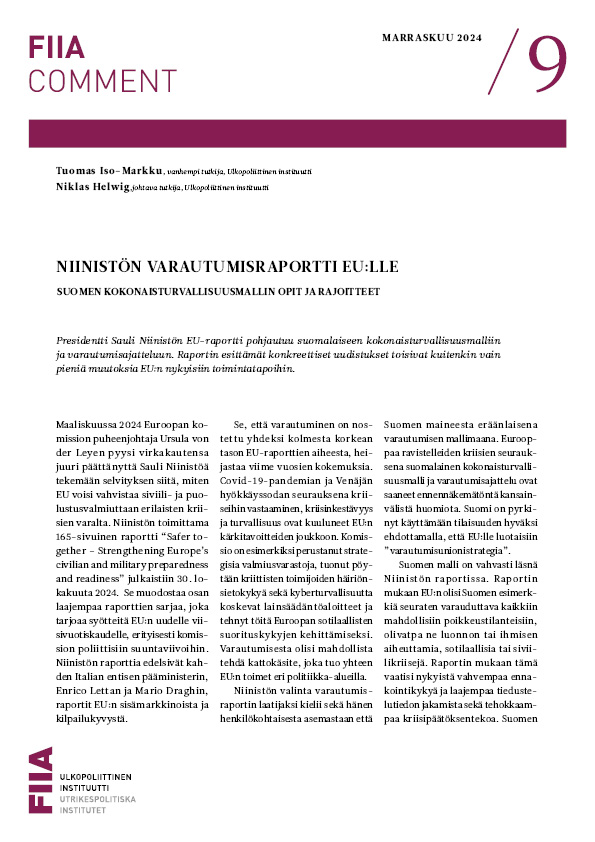If the policymakers from national governments, the EU and multilateral institutions want to bring about change and redirect large investment flows to clean technology in developing countries, their climate financing should act as an inducement for private sector financing.
The international climate conference will be held in Paris from the end of November to 11 December 2015. This will be the 21st session of the Conference of the Parties (COP 21) since the 1992 United Nations Framework Convention on Climate Change (UNFCCC).
French President François Hollande has stated that the COP21 accord will be impossible without financial commitments. Climate finance is public and private funding at national, EU and international levels to help developing countries cover the costs of dealing with the long-term impacts of climate change.
In accordance with the UNFCCC, developed countries are to provide “new and additional financial resources” to enable developing countries to undertake emission reduction activities and to help vulnerable countries adapt to the adverse effects of climate change. In Copenhagen in 2009, developed countries were committed to jointly mobilising USD 100 billion a year by 2020 in the context of meaningful mitigation action in developing countries. To date, the mobilisation of funds lags far behind the agreed goal.
Climate finance remains a highly controversial and complex issue on the Paris agenda. There is no commonly agreed definition for the mobilisation of climate funds. In the current economic situation, most industrialised countries are unwilling to approve a significant increase in governmental funding and they stress the importance of private sector funding.
Many developing countries, for their part, want to have limited or no private sector involvement for ideological or practical reasons. It is possible that vociferous argumentation against the participation of the private sector in climate financing is believed to maximise the share of public funding. The least developed countries are more receptive to private sector participation, since an effective and realistic agreement is in their interests. In Paris, the parties might agree on the objectives of climate finance, but they are unlikely to agree on how best to reach those objectives or what the role of the private sector should be.
The world can’t afford another summit that ends in acrimony between the developed and developing countries. If the policymakers from national governments, the EU and multilateral institutions want to bring about change and redirect large investments flows to clean technology in developing countries, their climate finance should function as a catalyst for private sector financing in both developed and developing countries. Public climate finance can serve as a good incentive in the mobilisation of private sector climate mitigation investments.
Even after COP21, climate finance will originate from multiple sources from the Green Climate Fund, which is a mechanism to redistribute climate money from the developed to the developing world within the UNFCCC, and from other multilateral funds as well as from bilateral development aid. The current economic situation will most probably lead to a growing role for climate finance within the existing development aid budgets because of the scarcity of new and additional financial resources. Simultaneously, the private sector is becoming a development driver while many governments are integrating development aid and trade promotion.
There are several obstacles to corporate climate finance. Many European and US companies, particularly small and medium-sized enterprises, don’t have sufficient knowledge of the circumstances in developing countries. The slow development of financial institutions and high interest rates in developing countries are not encouraging companies to invest. Public financing can lower the risk level and guarantee a certain profit for companies operating in developing countries.
A growing number of companies are looking for opportunities to finance low carbon solutions on a sustainable economic basis. The Peruvian Presidency at last year’s COP20 meeting launched the Non-State Actor Zone for Climate Action, which aims to provide momentum for the climate talks by showcasing the commitments of companies, cities and investors. During COP21, an Action Day has been scheduled where ministers and business leaders can meet, and a list of mitigation initiatives in which companies can participate has been prepared. At a national level, governmental entities and businesses can jointly seek out opportunities for climate finance.
At present, it is difficult to measure both public and private climate finance, and the UNFCCC’s Standing Committee on Finance is working on how it can best be measured. The OECD Research Collaborative is also tracking private and public climate finance flows, while the World Resources Institute and the World Business Council for Sustainable Development have developed a greenhouse gas emission accounting tool. Nonetheless, there are significant data, methodological and knowledge shortcomings in assessing climate finance flows. Further research and co-ordination are required to improve measuring principles so that common rules can be agreed. Measurability and transparency are bound to have a positive impact on private investments.
It is time to concretise, at every level, the way in which the private sector can become a major actor in the fight against climate change. In addition to the UNFCCC, positive steps can also be taken at EU and national levels. It is particularly important for countries with industries that have clear commercial goals and interests within the developing world to develop strategies on how to mobilise the private sector in climate finance. For companies, it is important to secure easy and transparent access to funds for profitable climate projects in developing countries.








